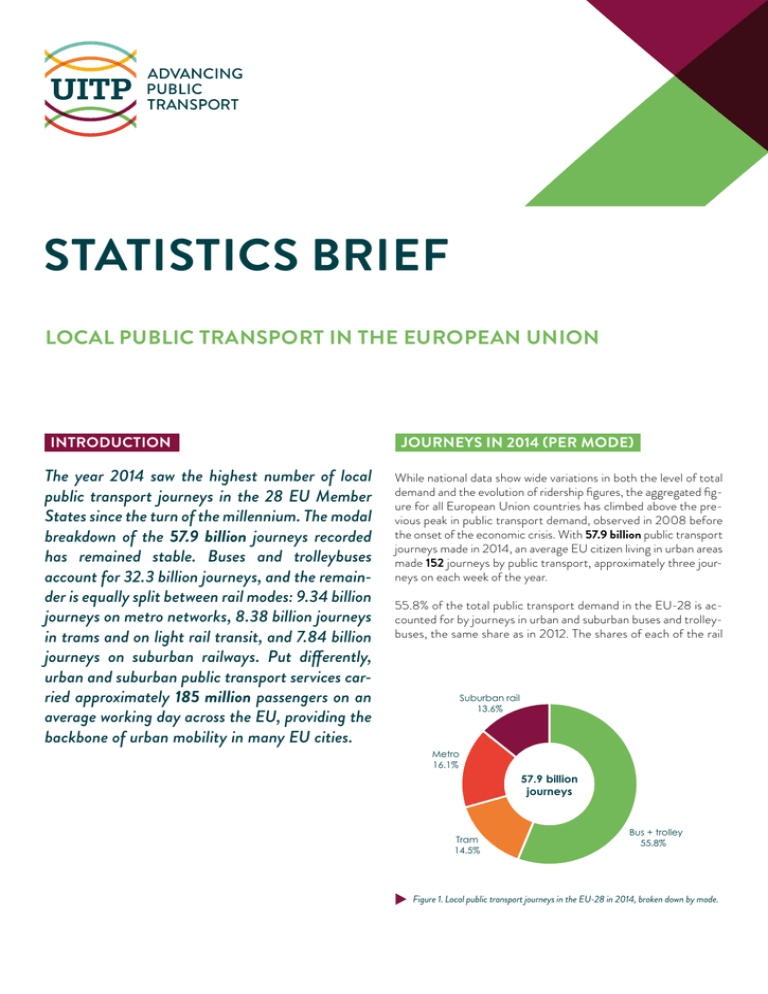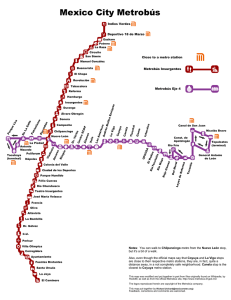statistics brief
Anuncio

STATISTICS BRIEF LOCAL PUBLIC TRANSPORT IN THE EUROPEAN UNION INTRODUCTION The year 2014 saw the highest number of local public transport journeys in the 28 EU Member States since the turn of the millennium. The modal breakdown of the 57.9 billion journeys recorded has remained stable. Buses and trolleybuses account for 32.3 billion journeys, and the remainder is equally split between rail modes: 9.34 billion journeys on metro networks, 8.38 billion journeys in trams and on light rail transit, and 7.84 billion journeys on suburban railways. Put differently, urban and suburban public transport services carried approximately 185 million passengers on an average working day across the EU, providing the backbone of urban mobility in many EU cities. JOURNEYS IN 2014 (PER MODE) While national data show wide variations in both the level of total demand and the evolution of ridership figures, the aggregated figure for all European Union countries has climbed above the previous peak in public transport demand, observed in 2008 before the onset of the economic crisis. With 57.9 billion public transport journeys made in 2014, an average EU citizen living in urban areas made 152 journeys by public transport, approximately three journeys on each week of the year. 55.8% of the total public transport demand in the EU-28 is accounted for by journeys in urban and suburban buses and trolleybuses, the same share as in 2012. The shares of each of the rail Suburban rail 13.6% Metro 16.1% 57.9 billion journeys Bus + trolley 55.8% Tram 14.5% Bus + trolley Tram Metro Suburban rail Figure 1. Local public transport journeys in the EU-28 in 2014, broken down by mode. modes have also remained stable, with 14.5%, 16.1% and 13.6% for trams and LRT, metros and suburban railways respectively. National variations in the share of the demand per mode are quite significant. In five EU countries rail modes account for over half of the passenger journeys: Austria, Croatia, the Czech Republic, France and Germany. Between 2013 and 2014, France, Italy, Poland and the UK had a combined growth of 0.6 billion journeys, driving up the total EU figure. Looking more closely at the last five years, 17 countries had higher public transport ridership figures in 2014 compared with 2010, but in only seven the growth was sustained over the five years: Austria, France, Germany, Lithuania, Malta, Sweden and the United Kingdom. Bulgaria is the sole country where public transport ridership dropped every year since 2010. The Czech Republic, Denmark, Ireland, Poland and Slovenia had one year of growth in ridership. Looking at the national level, Poland provides a typical example of the link between economic indicators and public transport demand: ridership in the country was on a slowly decreasing trend until 2013, when a major drop – over 6.5% decrease compared with 2012 – occurred. This development matched a large drop in the national inflation rate and private consumption rates being at their lowest level since 1996. Ireland is another example of the link: 2014 was the first year since the onset of the economic crisis when an increase in demand for public transport was reported in Ireland. The previous peak for Ireland was observed in 2007, before the economic crisis led to a significant drop in employment. Italy also provides an interesting example, with the number of journeys growing steadily until 2010, followed by two years of sharp decrease. The trend appears reversed with two successive years of growth in demand bringing ridership back to the 2007 level. EVOLUTION OF JOURNEYS BY BUS, TRAM AND METRO In 2014 approximately 49.8 billion journeys were made on local buses, trams and metros in the EU – suburban railway passengers are not included in the time series – the highest recorded figure since 20001. The evolution of public transport demand highlights the lingering effects of the economic crisis in Europe: from 2009 to 2013 the demand for public transport was fairly stable. As such, while 2014 was the year with the highest recorded ridership figures for local public transport, it remains to be seen if a new growth trend will be set for the sector. The total public transport demand figures for the EU-28 hide the heterogeneous nature of the national trajectories, which are quite strongly influenced by economic circumstances, particularly the rate of employment. 51 49.0 48.9 49 49.1 49.3 49.1 49.0 2013 49.8 49.6 50 2012 Billions Local public transport journeys in the EU28 2000-2014 48.1 48 46.5 46.4 2002 47 46.2 2001 47.2 47.6 46.7 46 2014 2011 2010 2009 2008 2007 2006 2005 2004 2003 2000 45 Figure 2. Public transport journeys by bus, tram and metro in the EU-28, 2000-2014 1. I n the first edition of this publication, covering the period 2000-2012, provisional data was used for several countries in 2012. The total EU-28 figure for 2012 was revised down from the initially reported figure. 2 The number of public transport journeys by bus, tram or metro was divided by the population living in urban areas within each EU country, to enable more meaningful national comparisons. The growth in public transport demand before 2006 was driven primarily by the growth of the urban population, with a stable figure of approximately 132 journeys per capita. Demand per capita peaked at 135 in 2008, followed by a decrease coinciding with the drop in employment brought by the economic crisis. 2014 was the first year since the economic crisis when public transport demand per capita increased to an average of 131 journeys per urban inhabitant. The majority of the countries ranking above the EU average in terms of public transport journeys per urban inhabitant are located either in Central and Eastern Europe or in Northern Europe. The CEE countries that joined the EU in 2004, 2007 and 2013 had – in general – rather high levels of public transport demand. Moreover, in these countries the number of journeys was generally on a slowly decreasing trend, which in many cases was accelerated when unemployment rose following negative economic performance during the crisis. Encouragingly, in the Baltic countries, Hungary and Croatia this trend appears to have stopped, with the number of journeys showing moderate growth since 2010. The map in figure 3 combines the 2014 levels of public transport journeys per urban inhabitant and the evolution in demand since 2010. 13 EU countries had levels of public transport demand per capita above the EU average – green and yellow colours. EU average 131 journeys per urban inhabitant in 2014* Increasing demand; journeys per capita above EU average (AT, HR, EE, DE, HU, LV, LT, LU, PT, SE) Increasing demand; journeys per capita below EU average (BE, FI, FR, IE, MT, UK) Decreasing demand; journeys per capita above EU average (CZ, PL, RO) Decreasing demand; journeys per capita below EU average (BG, DK, IT, ES) Insufficient information** (CY, EL, NL, SK, SI) *See methodology section. **In Cyprus, Greece, the Netherlands, Slovakia and Slovenia the number of public transport journeys per urban inhabitant is below the EU average. Due to changes in the methodologies used to estimate and report public transport ridership, the evolution trend could not be adequately established. Figure 3. EU-28 Public transport journeys by bus, tram and metro per urban inhabitant in 2014 and evolution trend in the previous five years. 3 Among countries ranking above the EU average, Austria, Finland and Germany exhibit different growth dynamics since 2000. • In Austria public transport demand grew at a relatively high pace since 2003, by over 2% per year, surpassing the growth in the number of Austrian urban residents. As a result, the country had the third highest level of public transport demand per capita in 2014, after the Czech Republic and Hungary. • In Germany the number of public transport journeys has also been on an upward trend, but at a slower pace: since 2011 public transport demand per capita has remained constant.2 • Finland on the other hand saw a sharp decrease in public transport demand from 2000 to 2006, a trend that has been reversed since. The growth slowed down in 2013 and 2014, and public transport demand per capita in Finland remains below the 2000 level. CAPITAL CITIES As public transport demand is generally higher in larger cities, this publication complements – where available – national level data with the public transport ridership figure in the capital city. The per capita demand for journeys by bus, tram and metro is usually higher in the capital city than the corresponding figure for the country. The biggest difference was observed in Bratislava, the Slovak capital having a per capita demand more than four times higher than the national figure. On average, demand per capita in the national capital (in the 23 capital cities where public transport demand could be accurately calculated) is approximately 2.5 times higher than the national average. These results are not in fact surprising, as larger cities are likely to have more extensive, multi-modal, integrated public transport networks. The positive evolution of public transport demand in Belgium, France and the UK is also worth mentioning. Belgium had the highest growth in public transport demand since 2000: the 2014 number of journeys is more than double the 2000 figure. The pace of growth in journey numbers has slowed down since 2010, with relatively stable demand per capita. In France, public transport demand has been on a high-pace growth trend since 2004. While still below the EU average, demand per capita in France has been increasing constantly. On the other hand, the UK public transport demand per capita has been stable since 2009, the number of journeys growing at roughly the same rate as the urban population. Figure 4 shows that except for the cases of Bucharest, Copenhagen and Warsaw, the evolution of demand in the country always matches the evolution of the capital city. Furthermore, in all but five cases – Luxembourg, Madrid, Paris, Rome and Stockholm – public transport demand is either growing faster, or decreasing more slowly, in the capital than in the entire country. In the Commune of Rome and Community of Madrid public transport demand has been decreasing at a higher rate than for the country, while in the regions of Evolution in public transport demand in the country 5% Luxembourg Paris 3% Vienna Stockholm Tallinn** Zagreb 1% -1% London Budapest Dublin Copenhagen Rome Helsinki* Warsaw Prague Madrid** Brussels Berlin Bucharest* Sofia† -3% -5% -5.00% *Bucharest and Helsinki: 2011-2014; ** Madrid and Tallinn: 2012-2014; † Sofia: 2013-2014. -3.00% -1.00% 1.00% 3.00% 5.00% Evolution in public transport demand in the capital city Figure 4. Average annual percentage change in public transport journeys over the past five years in each country compared with its capital city. 2. The evolution figures do not include S-bahn and R-bahn services. 4 Luxembourg, Paris Ile-de-France and Stockholm ridership has been growing at a slower pace than the national total. If a country has multiple cities with extensive public transport networks, national level ridership is less likely to be strongly influenced by developments in the capital. Germany, Italy, Poland and Spain were the only EU countries where ridership in the capital accounted for less than one third of the national total. In smaller countries the capital is likely to account for a significant share of the total number of journeys: Estonia, Ireland and Slovenia have the highest proportion of public transport journeys taken in the capital city. It is the evolution of this figure that makes an interesting reading, in 16 of the 22 countries analysed the share of the capital city within the total public transport demand has increased since 2010, meaning that an even higher proportion of public transport ridership is concentrated in the largest city. France, Italy, Luxembourg, Slovenia, Spain and Sweden show the opposite trend, with public transport in other cities carrying more weight in the national total in 2014 than it was the case in 2010. © Flickr/News Oresund METHODOLOGY Data for the number of journeys (defined as boarding in a public transport vehicle) by public transport is normally collected at local level by the companies operating public transport services within the urban and suburban areas, and then aggregated at national level. This report is the first attempt at collating and aggregating these data at the level of the EU as a whole. Building on the first edition of the local public transport trends in the European Union (published in 2014), this report adds ridership figures at national level for 2013 and 2014 and in some cases completes and revises the data from the previous years. Due to the lack of data at the national and EU level for suburban railways, this important component of local public transport has only been used for the most recent year, while progress in the number of public transport trips has been analysed for the other modes since 2000 (Fig.2). of the city, except for several cases where the wider metropolitan area provided a better match with the work catchment area of the national capital and the operating service area for the public transport companies: Copenhagen – MOVIA authority area; Helsinki – Helsinki Regional Transport Authority; Paris – Ile-de-France agglomeration; Luxembourg – Canton du Luxembourg; Madrid – Comunidad de Madrid; Stockholm – Stockholm County; London – Greater London Area. Data for public transport ridership in the capital city of the EU countries was collected primarily using data from the main public transport operator within the area. In order to make valid comparisons between the evolution of ridership at the national level and in the capital city, suburban rail services were not included. The capital city was defined primarily using the administrative area The calculation of per capita figures uses data published by the World Urbanization Prospects publication by the United Nations Department of Economic and Social Affairs. These annual figures were updated compared with the data used in the previous edition of this publication. The 2012 EU figure for public transport demand per urban inhabitant is 131 journeys per capita. Copenhague, Denmark 5 © Ferrocarrils de la Generalitat de Catalunya (FGC) Catalunya, Spain CONCLUSION 2014 was the first year of marked growth in the number of public transport journeys in the EU, following a period of stable demand since the onset of the economic crisis. Yet the relatively smooth developments at the level of the EU-28 mask significant national variations which are quite closely linked with the evolution of national employment figures. It will be interesting to see if the most recent increase in passenger journeys becomes a trend. Most of the Central and Eastern European countries who joined the EU since 2004 continue to have among the highest figures for journeys per capita, while in many of the ‘old’ EU Member States demand per capita is growing, driving the EU-28 average up. With a few notable exceptions, public transport demand appears to become more concentrated towards capitals, which are in many cases driving national-level trends. This is an official Statistics Brief of UITP, the International Association of Public Transport. UITP has over 1,400 members in 96 countries throughout the world and represents the interests of key players in this sector. Its membership includes transport authorities, operators, both private and public, in all modes of collective passenger transport, and the industry. UITP addresses the economic, technical, organisation and management aspects of passenger transport, as well as the development of policy for mobility and public transport world-wide. For further information, please contact Mircea Steriu, Statistics Manager - mircea.steriu@uitp.org A digital version is available on Mobi+ Rue Sainte-Marie 6, B-1080 Brussels | Belgium | Tel +32 (0)2 673 61 00 | Fax +32 (0)2 660 10 72 | info@uitp.org | www.uitp.org © UITP - All rights reserved


